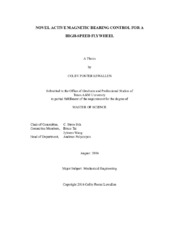| dc.description.abstract | Flywheel energy storage (FES) systems have recently gained momentum in the energy storage industry as a viable alternative to conventional lithium-ion and lead-acid batteries because they have superior energy density, faster charge rates, lack harmful chemicals, and are easy to repair. Contemporary FES research is focused on increasing the maximum operating speed of the rotor and reducing the power consumed by the active magnetic bearings. Therefore, the objective of this research was to implement a novel nonlinear controller called ‘wavelet-based time-frequency control’ (WFXLMS) in a computer simulation of a FES system with five degrees-of-freedom and compare its dynamic stability and active power consumption with a proportional-integral-derivative (PID) and fuzzy-logic controller scheme. Specifically, all three controllers were applied to a FES system operating at a high rate of speed and the amplitude of vibration, rate of convergence, and current draw were compared.
The results show that the ideal choice for a FES system is the WFXLMS controller. While it did draw the largest maximum current of any system, it used significantly less (half of PID and a quarter of fuzzy-logic’s) steady state current. This would drastically improve the energy storage duration; one of the main functions of a FES system. The WFXLMS controller is also the ideal system for higher operating speeds because of the system’s stability in the frequency domain. Comparing the average displacements shows that the WFXLMS controller had the largest average displacement (particularly in the z- axis), but the WFXLMS controller only used a fraction of the available clearance gap. If the FES system was used in an environment like space or a wind-farm where external excitations are limited, the WFXLMS controller is the clear choice. However, if external excitations are a real concern, the PID and fuzzy-logic controllers demonstrated a much quicker reaction time and would be the better choice. | en |


